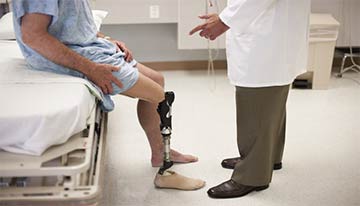Phantom Pain Rehabilitation With Mirror Therapy

Phantom limb pain is a very common condition following amputation. It is defined as painful sensations perceived in the missing part of an amputated limb. The number of people suffering from phantom limb pain is not known exactly but it is thought to affect up to 80% of amputees.
Post amputation pain management is very important to allow physical rehabilitation. Pain can be incredibly debilitating and affect many areas of life, including mood and self-esteem. Phantom pain rehabilitation with mirror therapy can allow you to have control over the pain and therefore progress in other areas of rehabilitation and life.
Mirror therapy has been shown by numerous studies to be effective in helping reduce phantom limb pain though the mechanism of how it does is still not known. A study by Chan et al (2007) tested six patients treated with mirror therapy, six who watched a covered mirror and six who completed visual imagery. After 4 weeks, the average pain rating fell from 30/100 initially to 5/100 in the mirror therapy group, remained at about 30/100 for the covered mirror group and rose from about 40/100 to 60/100 in the visual imagery group.
Theory 1
Phantom pain rehabilitation guides tend to recommend mirror therapy as it is easy to carry out and requires minimal equipment. One thought as to how it works is that phantom limb pain can be due to a tensed phantom limb, and because phantom limbs are not under voluntary control, relaxing is impossible.
Pain is experienced as there is no visual or proprioceptive feedback in the phantom limb to tell the brain it is okay. Mirror therapy allows illusions of movement and touch, and therefore relaxation in a phantom limb.
To carry out mirror therapy, the affected limb is placed behind a mirror and the reflection of the other limb moving is witnessed. The brain is “tricked” by this optical illusion and thinks your affected limb is moving without pain.
Using mirror therapy allows you to receive visual feedback that the phantom limb is relaxing and moving and therefore offers pain relief. This is because the brain prioritizes visual feedback over other senses. This model helps describe how mirror box therapy can provide immediate pain relief for some patients as soon as they are able to move or unclench the limb.
Theory 2
Another theory explaining the pathophysiology of phantom limb pain is cortical reorganization. The “plasticity” of the brain means it changes and adapts. Neuroimaging studies have shown that areas of the brain are changeable. Studies have found that, following amputation of the hand, the area in the brain where the hand would normally be represented shrinks, and is overtaken by representation for the face. When this ‘remapping’ occurs, it can create pain.
It has been found that the magnitude of phantom pain correlates with the degree of “remapping” of the brain. Reorganization can be partially reversed using mirror therapy and corresponds with a reduction in pain. This supports the idea that using mirror therapy helps “rewire” the brain back to its normal state, hence decrease pain in the long term.
Learn more on how to use mirror therapy here.